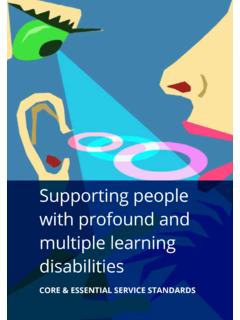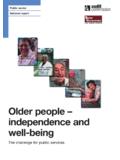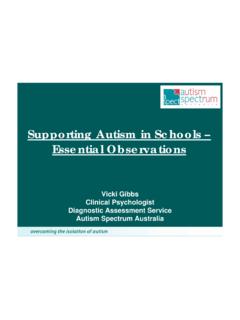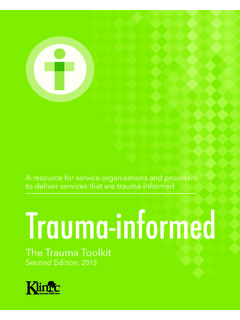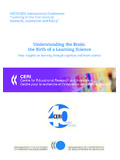Transcription of The Five Good Communication Standards: supporting the ...
1 Summary Many children and young people in care have unidentified and/or unmet speech, language and Communication needs. Left unidentified and/or unmet, these needs can have a range of negative consequences, including on their behaviour, social, emotional and mental health, ability to form relationships, literacy and ability to engage with education, and future life chances, including employment. They can also result in involvement in the criminal justice system. With appropriate involvement from speech and language therapy services, the Five Good Communication Standards can The Five Good Communication Standards: supporting the implementation of the 9 Quality StandardsChild A s storyChild A is 15.
2 Prior to her present placement, she had had 20 previous placement breakdowns. With a history of aggressive behaviour, including being verbally and physically abusive, she started her placement on a 3:1 staffing ratio due to the risk of assaulting staff. She had a large number of police charges pending. She had previously been identified as having no obvious difficulties with her ability to communicate, but that she would communicate emotion by behaviour. Following staff concern about her Communication skills and inability to understand information, a speech and language therapist undertook a full assessment of Child A.
3 This revealed that she had a range of unidentified speech, language and Communication needs. The speech and language therapist advised both Child A and those working with her how best to support her Communication needs, including when attending a result of this speech and language therapy input, Child A s Communication , social skills and behaviour have improved and the charges against her have been dropped. Staffing levels have been reduced to 2:1 and 1:1 support is being trialled at school. Her social worker commented, What I have experienced is Child A s much improved confidence in expressing herself, listening and understanding.
4 This has been an invaluable part of the progress she has made in placement and has allowed her greater opportunities to make meaningful relationships with adults and peers alike. help residential homes to evidence how they are supporting the implementation of the 9 Quality Standards for children and young people with Communication prevalence of Communication needs amongst looked after children Many children and young people in care have unidentified and/or unmet speech, language and Communication needs. A study published in the International Journal of Language and Communication Disorders in 2011 found high levels of Communication impairment amongst children and young people in residential care.
5 Much of it was severe and pervasive, and largely previously An Office of National Statistics review of the health needs of looked after children found that speech, language and Communication needs were the second most frequently reported difficulty for looked after No Wrong Door, the service for looked after children in North Yorkshire, found 62% of its children had Communication needs. Only two of these had previously seen a speech and language therapist (SLT).3 The background to looked after children s Communication needs Speech, language and Communication needs is the term used to describe difficulties across one or many aspects of Communication .
6 These include: language disorder and developmental language disorder4 these disorders create obstacles to Communication or learning in everyday life. They affect the way children both understand language (make sense of what people say) and use language (words and sentences) and can lead to difficulties with social Communication (knowing how to speak to different people in the right kind of way at the right time and understanding the non-verbal rules of Communication ); and difficulties with producing speech (including stammering and disorders of speech and voice).
7 Some looked after children s Communication needs may be associated with their environment. The majority of children in care experience conditions of poverty and social disadvantage5 and in areas of high social deprivation between 40% and 56% of children start school with limited ,7 Attachment difficulties and any previous abuse, neglect and subsequent trauma may also have had an impact on the development of looked after children s Communication ,9 Communication needs may be integral to other conditions, such as autism spectrum disorders and learning disability, or co-occur with them.
8 Such as attention deficit hyperactivity disorder and conduct disorder,10,11 complex needs, and profound and multiple learning disabilities. Priority tends to be placed on more visible difficulties, such as social, emotional and behavioural difficulties, or in some cases offending behaviours, and not on identification and intervention for those children with Communication needs. Social, emotional and behavioural difficulties could themselves stem from an unidentified and/or unmet Communication need. Two-thirds of seven to 14 year olds with severe behaviour problems have Communication ,13 Signs of speech, language and Communication needsSigns that children and adolescents may have Communication needs include14: they find it difficult to say what they want or to understand people .
9 They don t talk as much as children of the same age. they seem to get stuck on some words. people find it difficult to understand what they are saying. their voice sounds strange. they find it difficult to talk to other children and make friends. they get lots of colds and don t often hear what people say. The impact of looked after children s Communication needs Looked after children with Communication needs can have difficulty understanding what is being said to and asked of them. They can also have difficulty making themselves understood. Their needs are often hidden and older children in particular may have developed masking techniques.
10 Some looked after children communicate through behaviour that may result in offending behaviour. Common difficulties looked after children experience include social Communication skills (knowing how to speak to different people in the right kind of way at the right time), naming and managing emotions (including self-control), self-awareness, vocabulary, concepts related to time, working memory and the ability to retain, process, recall and sequence importance of identifying and supporting looked after children s Communication needsIdentifying and meeting their Communication needs helps looked after children and young people to communicate with those around them and supports their emotional, social and mental health and well-being, relationship building, educational attainment and future life chances.
